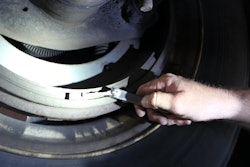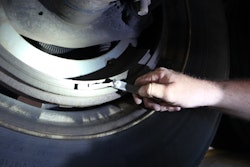Automated and mechanical transmissions share many common maintenance needs, but there are differences.
There is a lot of technology engineered into an automated transmission, but when it comes to maintaining them, it’s best not to let the component’s sophistication get intimidating.
“Your basics of maintenance are not going to be a whole lot different than what there would be for a mechanical system,” notes Bob Langbo, Eaton’s manager of global support services.
Many parts, such as housings and gears, will be common to both a mechanical transmission and its automated counterpart. And their ailments are similar as well: Add some contaminated air into a cylinder, and each style of transmission will struggle.
If anything, automated transmissions promise to present fewer maintenance challenges than their mechanical brethren.
“The statistic is a few years old, but at one point in time we were measuring on the order of a 20 percent reduction in internal transmission failures as a result of increased automation,” Langbo says as an example. The carefully calculated shifts reduce the wear and tear in transmissions, protect clutch teeth and even limit damage such as twisted drive shafts.
There is no question that the shifts are smoother. The driver at the controls of a mechanical transmission will think he is making a smooth shift if the equipment is within 100 rpm of being perfectly synchronized. “Automated transmissions will drop inside of 40 rpm,” he says. Fleets often report that the clutch wear associated with an automated transmission will match that of a mechanical transmission, which is controlled by the most experienced driver. “If the driver gets 600,000 miles out of a clutch,” he says, “my automated transmission is going to perform as well as him or her and we should be able to match clutch life.”
MAINTENANCE CHECKS
Still, this equipment does require some attention in the shop.The use of specific lubricants, such as a PS164 formula for an over-the-road application, is one important consideration. “The lubes coming out today do help to dissipate heat a little better than they used to. If you use certain lube specs, you don’t need to run a cooler like you did in the past with some applications and drivetrain configurations,” Langbo says. But incompatible fluids can lead to long-term damage to the transmission’s bearings or tooth face. They also can sacrifice gains in fuel economy.
Langbo suggests that maintenance teams should pay particular attention to the quality of vehicle power and grounds during any troubleshooting efforts.
“Certainly with the onset of more ECUs [Electronic Control Units] on the truck, understanding the ground path and the quality of the ground path is becoming increasingly more important,” he says. “Worse yet, if you try to diagnose an automatic or automated system having trouble and don’t have the proper ground reference to start from, all your measurements and isolation techniques from that point would be invalid.”
Today’s data links are being crowded full of messages regarding everything from the transmission to antilock brakes. If the ECUs are all on different relative grounds – a problem that could be introduced after post OEM modifications – there are going to be communication challenges.
A data link’s impedance also can be altered if someone hangs another device on the system, Langbo adds, referring to one case in which an array of ECU failures were linked to the installation of new power inverters, which generated interference on the ground path.
When it comes to reading the fault codes, Langbo also stresses the importance of watching the related time stamps. “We certainly had instances where technicians [went] down the path on one fault code that was three weeks older than another one,” he says. And if there are several fault codes with a current time stamp, it will be important to determine the common denominator. “That’s back to troubleshooting 101. It could be power and ground.”
A clearly defined fault code often can be addressed by following a simple troubleshooting tree, even if the issue involves the ECU itself. Reading the manual for ZF’s FreedomLine transmission offers a few of the examples. If the ECU temperature is too high, the technician will need to check for obstructions in the transmission cooler, cooler lines and bypass valve. Low and high oil levels also can lead to overheating. Meanwhile, if the speeds of the input shaft and output shaft do not match the expected ratios, the technician will need to check the ECU for programming errors and the wiring harness for short or open circuits.
Even the condition of a fuel filter can have an impact on the transmission’s performance. “This is something that is frequently missed,” Langbo suggests. The ECU monitors road speed and engine speed, but the transmission may not reach the required shift point if there is not enough fuel getting to the engine. The driver at the controls of a mechanical transmission will complain that his engine will not get above 1,300 rpm, but the driver with an automated transmission will complain that the transmission won’t shift.
Ultimately, the drivers of the equipment may provide the most important diagnostic information of all. “The only person with a brain at the point of failure was the driver,” Langbo says, referring to how their observations will help to reproduce any failures. “The ECU is along for the ride.”
TOOLS FOR TROUBLESHOOTING
Luckily, technicians also are becoming more familiar with the diagnostic tools that can help to troubleshoot different issues, but the transition may be more recent than some people think. “I was a field trainer in the mid 1990s and there were guys at that point who didn’t know how to use a digital volt ohms meter,” he says.
Having the tools is only part of the solution. They also have to be used properly. For example, the probe on a digital volt ohm meter’s lead is not designed to fit every pin, and the issue should not be addressed by jamming a paperclip into the space. It may generate a reading at that point in time, but it also will stretch out the socket and eliminate any chance of a proper fit during the troubleshooting procedures to come.
Any cost-conscious shops that balk at the cost of the latest communications box also need to be aware that they are effectively “neutering” the tools that are available. “It is a cost,” he says. “These are necessary tools for doing business.”
There will be a value in the proper training to use the tools as well. “I know it’s an investment, but if you spend $600 to $800 on a training class for a technician,” Langbo says, “you’ll make that up in avoiding one bad repair.”









